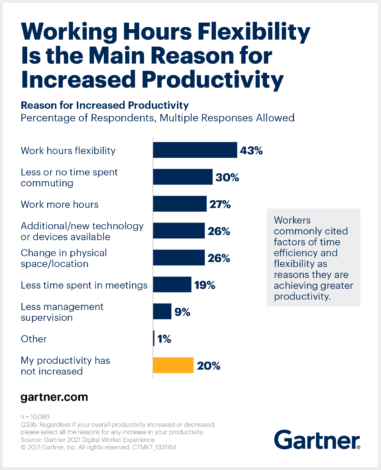11 Expert Tips on How to Improve Team Productivity (in 2025)
Organizations face numerous challenges when it comes to improving team productivity, such as outdated technology, financial issues, remote work-related challenges, and well-being concerns. These challenges can have an impact on team morale and productivity, resulting in decreased workplace efficiency and effectiveness. However, by addressing these issues, organizations can boost team productivity while meeting business objectives.
In this article, I will share 11 expert tips for increasing team productivity this year. Besides, I’ll discuss the latest trends and share the best strategies for dealing with equipment and technology-related issues, improving team communication and collaboration, prioritizing employee well-being, promoting employee training and team development, implementing salary transparency, recruiting top talent, setting clear and realistic goals, fostering an excellent team culture, and encouraging ongoing learning among your employees, to engage them in their work engaging and make it more fulfilling.
Outdated technology significantly reduces team efficiency and decreases employee productivity. Slow computers, outdated software, and insufficient internet connections can cause delays and frustration at work. To tackle this issue, organizations must consider seeking support from a reliable company that can help them invest in cutting-edge technology and modern equipment to help their teams work more efficiently and effectively. Using Jira templates for tasks can also simplify task assignments and tracking, helping teams stay organized and maintain consistent progress on complex projects.
Ensuring that financial processes, including the use of a financial modeling tool, do not detract from productivity is essential. Employers need to navigate state-specific regulations to determine whether they can require this payment method from employees and ensure compliance while maximizing operational effectiveness.
2. Improve communication and collaboration
Effective communication and enhanced collaboration will be critical to increasing team productivity in 2025, especially because of the adoption of remote work. Companies can platforms such as video conferencing, instant messaging tools, and project management platforms to create better communication channels. Employees can also benefit from clear communication expectations, such as regular check-ins and structured meetings. Additonally, adopting engineering project management software enables engineering teams to streamline task allocation, monitor project milestones, and collaborate seamlessly across departments, which is especially crucial for maintaining efficiency in remote or hybrid work environments.
Kudremukh Iron Ore Limited (KIOCL)|Case Study
KIOCL provided their employees with secure tools for collaboration, video calls, and team messaging by implementing TrueConf Server. An autonomous system unified more than 1,000 employees allowing to facilitate work meetings in hybrid and online modes from any location.

Establishing guidelines for team communication and collaboration can boost efficiency and reduce errors caused by miscommunication. For teams, effective collaboration is essential to sharing knowledge, discussing key concepts, and ensuring thorough preparation. Integrating tools like time tracking software can further enhance team productivity by providing visibility into task durations and helping teams stay aligned on goals.
It is important to note that different teams may require different communication and collaboration methods, so it is critical to regularly evaluate these strategies and adjust them to best suit the needs of each team.
Effective collaboration relies on having clear and specific goals. These goals should be straightforward, specific, measurable, attainable, relevant to the project, and time-bound. They also have to be clear for everyone and visualised for a uniform interpretation. Leveraging advanced engineering analytics systems can further optimize workflows, enabling businesses to analyze complex operations and implement data-driven improvements for maximum efficiency.
3. Prioritize employee and team well-being
A study conducted by the WHO revealed that anxiety and depression cost a loss of approximately $1 trillion each year in productivity to the global economy.
Stress, burnout, and other mental health issues can cause a negative impact on team productivity. Companies must offer a perfect work-life balance and reduce stress by implementing strategies such as flexible office schedules, mental health day offs, employee wellness programs, and more. Celebrating individual and team accomplishments through employee recognition software can significantly improve morale and create a supportive atmosphere, ultimately enhancing overall productivity.
Prioritizing employee well-being, employees’ mental and physical health ensures long-term productivity and offers amazing morale benefits. Furthermore, with today’s jobs tending to push employees towards a sedentary lifestyle, this increases the risk of developing chronic diseases such as obesity, type 2 diabetes, hypertension, high cholesterol, and more.
Take your team communication to the next level with TrueConf!
A powerful self-hosted video conferencing solution for up to 1,000 users, available on desktop, mobile, and room systems.
4. Invest in employee training and development
Career development programs and training initiatives can help enhance employees’ skills significantly and boost their productivity. Integrating an LMS with sophisticated training tracking system can further optimize these initiatives, ensuring skills development aligns with organizational goals. Companies must craft personalized learning courses and offer guidance and mentorship to employees.
Remember to include upskilling courses, reskilling lessons, and videos in your employee development initiatives through an LMS for HR. This will help your team members adapt to new technologies, enhance their knowledge, and stay abreast with the latest updates and trends in the industry.
Integrating automated expense management can further enhance operational efficiency, allowing HR and finance teams to allocate more time to strategic initiatives. This can be effectively utilized to foster employee growth and organizational success.
5. Be transparent and honest about salaries
Implementing salary transparency can boost team morale and increase productivity. Adhering to the pay transparency directive not only fosters a culture of openness and trust within organizations but also aligns with evolving digital trends in the financial services sector, demonstrating a commitment to fairness and equity in the workplace.
Companies can implement open salary policies and conduct pay equity audits on a timely basis. This will ensure that all team members are paid fairly and equally. Communicating the pay structure openly (e.g., with an hourly to salary calculator) develops a sense of trust and transparency among employees.
6. Hire top talent from all around the globe
Companies are increasingly hiring employees from diverse backgrounds, cultures, and different geographical locations to drive innovation and success. Hiring expert professionals belonging to diverse backgrounds introduces your team to fresh ideas, new perspectives, and novel ways of thinking.

However, it is critical to consider the difficulties of managing a remote workforce, such as cultural differences, time zone issues, language barriers, and more. Hence, it is advisable to foster a welcoming and inclusive workplace culture that values this diversity and offers excellent resources for handling a diverse team.
7. Hire people smarter than leaders for innovative quick solutions
In today’s fast-paced business world, innovation is a critical driver of growth and success. It is critical to recruit people who are smarter than your leaders and have outstanding skill sets in order to drive innovation, where recruitment tools come in handy. These individuals can bring new ideas and interesting perspectives to the team, resulting in more creative and effective problem-solving solutions.
Companies are implementing new strategies such as skills assessments and collaborative hiring processes to identify and hire top talent with diverse skill sets. Skills assessments can assist in evaluating candidates’ abilities in specific areas, whereas a collaborative hiring process can provide a more comprehensive picture of a candidate’s fit with the existing team and the company culture.
8. Give clear and realistic goals
Setting achievable goals is critical for the team’s success. Utilizing a dedicated project management website helps teams define clear objectives, allocate resources efficiently, and track progress with greater transparency.
One goal-setting trend is the use of agile goal-setting methodologies, which entail breaking down large goals into smaller, more manageable ones. This approach can assist teams in remaining motivated and focused while adapting to changing circumstances or priorities.
For a more structured approach to developing individual team capabilities, implementing a skill management software can help. The entire team must understand the business goals and know their respective roles in achieving them. This improves communication and strengthens collaboration within the teams.
9. Foster a positive team culture
Encouraging and positive team culture can significantly improve employee productivity and team well-being. For employees, financial stress is often a significant source of anxiety and distraction. Employers can help by offering financial wellness programs, such as financial planning, financial education, or gift cards.

10. Encourage ongoing learning and development
As per LinkedIn’s 2021 Workplace Learning Report, 94% of the workforce would stay at a company longer if the company invests in career development initiatives.
In today’s world dominated by AI and automation, many employees may be concerned about their roles getting replaced by technology or automation. Companies can address this issue by devising a performance improvement plan that includes investing in ongoing learning and career development opportunities for their teams, such as upskilling and personalized learning courses, reskilling programs, mentoring, and more.
11. Make work more engaging and fulfilling
Engaged employees are satisfied with their jobs and are productive and dedicated to their employment. While employees who are bored or disengaged are often more likely to be less productive and committed to their work. Hence, it is critical for businesses to find new avenues to transform their work processes to make it more interesting and fulfilling for their teams.
Social learning is another aspect that most companies are currently investing in. Learning from others, such as through collaboration and mentorship, is an example of social learning. Companies can promote social learning programs by encouraging employees to collaborate on complex projects, share knowledge, guide other team members with their industry expertise, and offer genuine feedback to one another — especially when supported by SaaS consulting that helps design platforms and processes for sharing knowledge effectively. This ensures employees are more invested in their work and build cordial relationships with their colleagues resulting in better engagement and improved productivity.
Wrapping Up
Team productivity is an important factor that defines success for most businesses in 2025. Companies can ensure their teams work more productively, efficiently, and effectively by addressing the challenges they face in areas such as technology, communication, employee well-being, training, and goal-setting.
Furthermore, organizations can make their employees feel more satisfied in their work and more committed to the company’s success by creating an encouraging work culture, and offering career growth opportunities, thereby making work interesting and fulfilling.
Companies can set themselves up for success by helping their teams thrive in 2025 and throughout by implementing these tips and strategies.
Author Bio: Manas Chowdhury is a Digital Marketing enthusiast with a PG in Economics and a specialization in Finance. He is an entrepreneur who has a keen interest in stocks, bullions, gaming, and blockchain technology. While he runs his own startup, he also enjoys writing on a variety of topics. Being a philanthropist, he is also involved in various activities contributing to the betterment of the environment and society. You can connect with Manas on LinkedIn.




Follow us on social networks